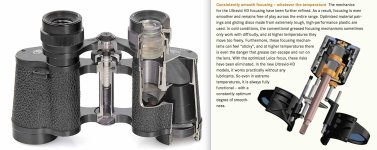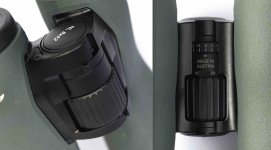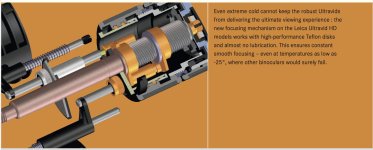-
Welcome to BirdForum, the internet's largest birding community with thousands of members from all over the world. The forums are dedicated to wild birds, birding, binoculars and equipment and all that goes with it.
Please register for an account to take part in the discussions in the forum, post your pictures in the gallery and more.
You are using an out of date browser. It may not display this or other websites correctly.
You should upgrade or use an alternative browser.
You should upgrade or use an alternative browser.
Sticky Focus Wheels (1 Viewer)
- Thread starter Upland
- Start date
More options
Who Replied?
I believe focus wheels are still universally being lubricated with traditional petroleum base grease. If synthetic grease was used I think the wheels would be much smoother plus they wouldn’t stiffen up nearly as much in the cold. Thoughts?
A lot of binoculars have moved to a greaseless focuser.
Any idea which ones?A lot of binoculars have moved to a greaseless focuser.

Swarovski have been using greaseless focusers for decades, Zeiss do on the HTs and presumably the SFs, not sure about all manufacturers...Not enough coffee yet. Thought you were referring to synthetic grease. My reading comprehension only kick in after the second cup lol.
Interesting that there are greaseless wheel. I would think the surfaces would have to be incredibly smooth
Interesting question - what are they using these for grease these days. For the greased focusers.I believe focus wheels are still universally being lubricated with traditional petroleum base grease.
I had two pairs of 7x35E Nikon porros serviced last year. I assume it was with the most modern synthetic grease available. The focuser action is now so smooth and velvety I think it is probably better than when the binos were new in the 80's. Same with the Dialyts I had serviced by Zeiss. I would assume Nikon & Zeiss are using synthetic grease in their new binos but there's no way to know for sure.
John A Roberts
Well-known member

Typically with centre focus binoculars . . .
Due to mechanical needs, external focus designs require heavy grease on the focuser shaft *
But in contrast, internal focus designs are able to largely dispense with lubrication.
By way of comparison:
a) Zeiss Jena 8x30 Deltrintem from a 2016 listing by Liveauctioneers, and;
b) Leica Ultravid HD focus mechanism from 2007 catalogue (note the reference to 'practically without any lubricants').

* and Russian Komz binoculars also used greased felt around the eyepiece bodies to provide water resistance!
See post #8 and on at: https://www.cloudynights.com/topic/813604-habicht-10x40-comparisons/
John
Due to mechanical needs, external focus designs require heavy grease on the focuser shaft *
But in contrast, internal focus designs are able to largely dispense with lubrication.
By way of comparison:
a) Zeiss Jena 8x30 Deltrintem from a 2016 listing by Liveauctioneers, and;
b) Leica Ultravid HD focus mechanism from 2007 catalogue (note the reference to 'practically without any lubricants').

* and Russian Komz binoculars also used greased felt around the eyepiece bodies to provide water resistance!
See post #8 and on at: https://www.cloudynights.com/topic/813604-habicht-10x40-comparisons/
John
Last edited:
John A Roberts
Well-known member

. . . and on occasion there's also been problems with the NL e.g. see: NL Focus Wheel Problems After Washing
Perhaps aggravated by the unusually enclosed focus wheel?

Images from Roger’s review at: Swarovski 8x42 NL Pure Review
John
Perhaps aggravated by the unusually enclosed focus wheel?

Images from Roger’s review at: Swarovski 8x42 NL Pure Review
John
Last edited:
Joe H
Well-known member

I’m not sure if the following is pertinent, but my 20 year old 8x32 ELs developed a (to me) less than acceptably rough focus knob. Instead of sending them in for repair, I squirted WD-40 behind the plastic/rubber focus knob and turned it back and forwards a few times. The improvement in smoothness was immediate. Then I took some pieces of normal typing paper, about twice as wide as a paper match, and slipped them behind the focus knob and moved them around to absorb the dirty WD-40. I didn’t want to leave an excess of the penetrating oil in there. Once I was unable to absorb any more of the liquid, I did a few more stop-to-stop turns on the focus knob and it feels like new again. This was about six months ago. I don’t recommend this course of action since Swarovski has a great service program, but I was pretty sure a couple of decades of hard use saw a buildup of dust or whatever behind the focus knob, and I was also pretty sure I could clean it out without any harm being done. Maby a flush with warm water would have worked as well, and would have been less likely to cause warranty issues, but as I mentioned above, I was pretty sure the process I used would work. Luckily it did.
dorubird
The unskilled mechanic blames his tools!

Interesting discussion. I think that the feeling of graininess of the focusers I experienced with Leica Ultravid and Swrovski EL comes from the fact that they are not lubricated. The big enigma for me is the SF Victory, what type of focuser does it have? Judging by how well it behaves, it seems to be greased. However I didn't notice any movement differences between winter and summer, which leads me to think that it may not be lubricated. I'm not sure! Does anyone know from Zeiss technical sources, what type of focuser SF Victory 42mm series has, greaseless or greased?Swarovski have been using greaseless focusers for decades, Zeiss do on the HTs and presumably the SFs
Zeiss SF 10x42 focuser is the best I've tried. I can characterize it as very butter smooth and quick response to the slightest movement. Also, the position of the focus wheel in the center of gravity of the binoculars, which is closer to the eyepieces, plays an important role in perfect ergonomics and stability. I took a very suggestive picture of how Zeiss SF can balance over the edge of "the abyss" by more than half of its length. Do not try this at homeView attachment 1574701View attachment 1574702
Nikon MHG 8x30 focuser is a bit firm, exactly as I needed. It has a kind of "elastic" movement with very pleasant viscosity feeling. This pleasant elasticity, however, takes away a little from the accuracy of movementView attachment 1574704
Swarovski Habicht 7x42 came with a very stiff focuser. But this disadvantage is compensated by the fact that has accurate focuser without jerking, and has a smooth spin, like a knife in a hardened butter. After using it over time, it lost some of its stiffness, becoming easier to spin and more pleasant. However, it has the stiffest focuser of my binoculars. I think this feeling is also due to the fact that the focus wheel is metal and very thin compared to its diameter (for example Habicht focuser it is three times thinner than Leica Ultravid 8x20 focuser, and twice larger in diameter than Leica one. This makes it hard to spin)View attachment 1574706
Leica Ultarvid 8x20 focuser has firmness and accuracy throughout the movement but has a slightly grainy movement that makes it feel less smooth/ continuous. However, the focus wheel is very large for a pocket binoculars, making it more ergonomic, easy to handle and increases spin comfort.View attachment 1574705
Bonus
My Swarovski EL 8x32 specimen that I tested had a grainy and inconsistent movement. Swarovski focuser moves more easily in one direction than the other, with a slight hesitation when changing directionView attachment 1574714
Even if I have my personal preferences reflected in this table, personally I can get used to any of these focusers, and I can learn the habit curve of each binocular very easily!
View attachment 1574716
tenex
reality-based
Possible translation confusion here: "it works practically without any lubricants" meaning...note the reference to 'practically without any lubricants'
"it works with almost no/hardly any lubricants" -- a bit puzzling
"it works well in practice without lubricants" -- my guess, also agrees with the claim that risk has been "eliminated"
Ignatius
Pigasus J. Pig IX for President

I believe graphite to be a good lubricant, as it is dry, doesn't attract/ bind dirt and afaik does not react with plastics/rubber. It is also not prone to freezing. Neither does it become runny.
In Mr. Roberts' image I think the yellow material on the right (Leica) to be sintered bronze. Bronze bearings are, or at least were, used for propeller shafts in ships as they require no moving parte, ie. balls or needles. Their advantage is no corrosion (unless it comes into contact with certain chemicals, such as chloride), hard wearing and the material is 'self-lubricating' as it were although it initially does require a lubricant. Since in binoculars the stresses on the parts are minimal, maybe that initial lubrication may be skipped.
In Mr. Roberts' image I think the yellow material on the right (Leica) to be sintered bronze. Bronze bearings are, or at least were, used for propeller shafts in ships as they require no moving parte, ie. balls or needles. Their advantage is no corrosion (unless it comes into contact with certain chemicals, such as chloride), hard wearing and the material is 'self-lubricating' as it were although it initially does require a lubricant. Since in binoculars the stresses on the parts are minimal, maybe that initial lubrication may be skipped.
Last edited:
John A Roberts
Well-known member

Ignatius
Pigasus J. Pig IX for President

Thank you for that, Mr. Roberts. Do you think the teflon disk referred to is the grey disk abutting the yellow element running on the middle part of the thread on the central shaft? I do not know enough about material science in engineering to know about the moldability and toolability of teflon. I only know of teflon as a thin layer or membrane or as a constituent of aerosol lubricants (PTFE). So can this stuff be produced as 'blocks' from which things such as disks can be machined? Or are these Leica disks made of some metal with a teflon coating?
tenex
reality-based
OK, that appears to settle the language issue, thanks.along with accompanying text referring to 'almost no lubrication'
Users who are viewing this thread
Total: 2 (members: 0, guests: 2)





